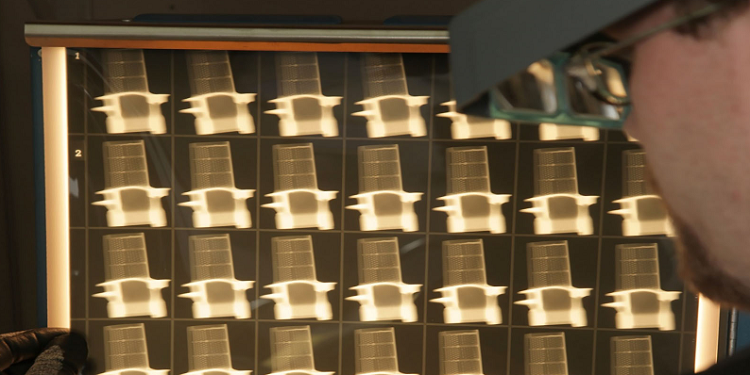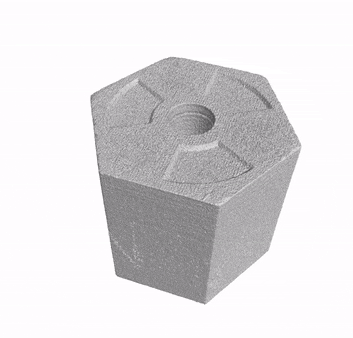A microreactor is a small container with two important components: a stir bar to mix chemical samples, and a thin needle for spraying and ionizing the samples for analysis with a mass spectrometer. The device is a new, smaller type of nuclear reactor that has the versatility to be used in many energy applications, and we’ve seen plenty of research regarding the 3D printing of microreactors. In fact, Purdue University’s College of Engineering has just been awarded an $800,000 grant from the US Department of Energy (DoE) in order to work on an important project that should speed up introduction of a 3D printed microreactor.
The funding came specifically from the DoE’s Nuclear Energy University Program, or NEUP, which was created more than ten years ago in order to consolidate economic support for universities under the same initiative, as well as to integrate university research within the Office of Nuclear Energy’s technical programs.
Earlier this summer, the DoE announced that it would be awarding more than $65 million in order to advance nuclear energy research at laboratories and universities across the United States. Thanks to this government investment, Purdue will be positioned to contribute to the DoE’s Oak Ridge National Laboratory (ORNL) Transformational Challenge Reactor (TCR) Demonstration Program, which is on a mission to build the first fully 3D printed microreactor by the year 2023. The overall goal is to find helpful solutions for the long timelines and sky-high costs that threaten nuclear energy’s future. This 3D printed microreactor will also be the first advanced reactor in over four decades that will operate on US soil.
“Purdue Engineering has ideal strengths to support the mission of the Department of Energy on the development of additively manufactured microreactors. We bring together deep expertise and collaborative capabilities, encompassing manufacturing, nuclear engineering, materials engineering, environmental engineering, AI and data analytics, nuclear reactors modeling and simulation, and systems engineering,” said project leader John W. Sutherland, the Fehsenfeld Family Head of Environmental and Ecological Engineering. “In this project, we’ll be blending fundamental science and engineering in a very complex and dynamic environment.”
Purdue will help by creating and demonstrating a novel artificial intelligence method that will help ensure that the components for the 3D printed microreactor are of good quality.
Hany Abdel-Khalik, technical lead for the project and associate professor of nuclear engineering, explained, “Microreactors introduce a transformational trend to the nuclear industry – a trend that enables more streamlined construction and deployment processes to address the nation’s energy challenges that cannot be overcome solely with large-scale nuclear reactors.
“Purdue will fill a technological gap in the nuclear industry, reflecting a broader trend of applying AI strategies to support additive manufacturing (AM). AM enables designs to be adjusted during manufacturing, greatly decreasing production cost and time. Our work is aimed at driving widespread adoption of additively manufactured reactor components by using an AI-powered software system to ensure safety and reliability.”
Other members on the Purdue team are Steven Shade, the Ball Brothers Director of Advanced Manufacturing Initiatives, who is also affiliated with Environmental and Ecological Engineering, and materials engineering professor Xinghang Zhang, a co-principal investigator with a background in advanced manufacturing.

Hany Abdel-Khalik meets virtually with John W. Sutherland (top on screen), and Xinghang Zhang. (Image courtesy of Purdue Engineering)
The project the team is working on is meant to drive adoption of 3D printing, AI concepts, and computation materials modeling in fabricating components for nuclear reactors, in order to lower development time and manufacturing costs, provide convenient and reliable access to nuclear power, and estimate safety risks in a realistic manner. According to Xhang, Purdue’s solution will use an advanced form of machine learning called reinforcement learning, which works to maximize cumulative rewards by looking at how software agents should act in an environment in order to achieve the rewards.
The team will use reinforcement learning to regulate the selection of 3D printing process parameters, like melting temperature and print speed, in order to guide decision making and train the AI models. So this funding from the DoE will definitely help.
“Synchronized application of additive manufacturing and artificial intelligence techniques are key to providing the most data-rich and cost-effective nuclear component qualification process. This is one of the key goals of DOE-NE’s TCR program: using modern technology to deliver a new and better way to deploy nuclear energy,” stated Kurt Terrani, director of the TCR program at ORNL.
“The program is engaging the industry, the regulator and, in this case, universities in order to ensure an optimal approach is developed and adopted in widespread fashion. The technical strength of the Purdue team will shore up our ability to deliver on these goals.”
(Source: Purdue University)
Subscribe to Our Email Newsletter
Stay up-to-date on all the latest news from the 3D printing industry and receive information and offers from third party vendors.
You May Also Like
Polls of the Week: Are 3D Printed Guns a Threat and Should We Regulate Them?
One of the most controversial topics in the 3D printing industry, hands-down, is guns. It’s been a major point of contention for years, and people typically have very strong opinions...
3D Printing News Briefs, April 3, 2024: Kickstarter FDM 3D Printer, Artificial Eyes, & More
In 3D Printing News Briefs today, we’re talking about an FDM 3D printer on Kickstarter, advancements in artificial eye creation, and 3D printed solenoids for electromagnets. Then we’ll move on...
Daring AM: The Global Crackdown on 3D Printed Firearms Continues
In the last few years, a surge in police raids uncovering 3D printed guns has led to concerns about their growing association with criminal gangs. Although typically seen as inferior...
Daring AM: Canada Tackles Increase of 3D Printed Gun Arrests and Sentences
Recent incidents in Canada have brought to light the arrest of individuals for possessing illegal 3D printed firearms, among other charges. These incidents, which resulted in multiple arrests, serve as...































